 【 Photo: Popular Korean foods 】
【 Photo: Popular Korean foods 】Of the gift items available, many tourists choose to purchase local foods as a gift. Since some food items have a short shelf life, they require extra care and attention. Here are some Korean food items that are popular and have a relatively longer shelf life.
Kimchi
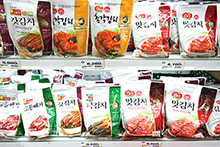
Kimchi is Korea’s representative healthy side dish and is made by fermenting salted cabbage, radish, fermented fish sauce and various vegetables in a red chili pepper sauce. The types of kimchi vary by region, season, and even the making process. The representative varieties include baechu kimchi (kimchi), kkakdugi (diced radish kimchi) and yeolmu kimchi (young summer radish kimchi). Baekkimchi (white kimchi), a variety made without red chili pepper sauce, is popular among people who dislike spicy foods. Kimchi contains an abundance of vitamins and minerals, helping to strengthen one's immunity to bacteria and cancer.
Vacuum-packed kimchi can prevent any leaks and is recommended for travelers planning to take it home as it will pass the stringent customs. Various vacuum-packed kimchi products are readily available in department stores, supermarkets, convenience stores and duty free shops.
Gochu-jang
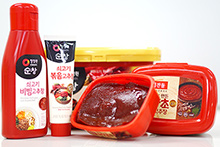
Gochujang (Korean chili paste) is a traditional fermented condiment with a combination of sugary, salty and spicy tastes. It is made by fermenting a mixture of rice powder, Korean chili pepper powder, malt oil, fermented soybean powder, and salt. Gochujang contains an abundance of nutrients and the spicy taste that comes from capsaicin stimulates one's appetite and improves digestion.
Gochujang is packaged in plastic tubs or tubes with varying degrees of spiciness and can be found in supermarkets, convenience stores and duty free shops. The standard unit of spiciness, running from one to five, is ‘GHU’ (Gochu-jang Hot taste Unit). This unit system is handy for purchasing gochujang; the higher the unit, the stronger the spiciness.
Gim
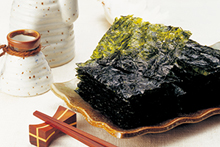
Gim (laver), a must-buy item among tourists, is made from dried seaweed that contains a variety of vitamins and minerals. Five pieces of gim contain the same amount of protein as one egg, and the amount of vitamin A in one piece is equivalent to the amount found in two eggs. In particular, Korean gim has received much enthusiasm from international food connoisseurs for its unparalleled quality, making for a luxurious souvenir.
Gim comes in a variety of types and packaging methods, which can be easily found in supermarkets. Since it is particularly susceptible to moisture and can easily go stale, it should be stored in an airtight container or bag.
Insam

Insam (Korean ginseng) is a root with a bitter taste and strong flavor that is named after its shape that resembles a human body. There are three types of insam: susam (fresh ginseng), which is unprocessed and picked right out of the field; baeksam, which is dried insam; and hongsam (red ginseng), which is steamed and then dried. Insam has long been used to boost one's health, with the effect varying by type, harvest time, and preparation method. The health benefits, including an immunity boost, help in fighting cancer, and a speedy recovery from fatigue, all come from the saponin and ginsenoside within insam.
Insam is a high quality souvenir, and can be purchased in specialty shops within department stores and supermarkets. It is mostly available in forms of extracts, candies, jellies, and other easy to consume products in neat packages, making for a perfect gift.
Ramyeon
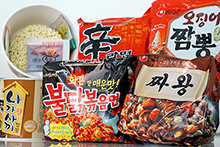
Ramyeon, Korean instant noodles, is one of the most popular foods in Korea. The low cost and easy cooking method have made ramyeon a popular souvenir even among tourists. While the most common ramyeon is spicy, there is a plethora of flavors available, from non-spicy broths including udon flavor to stir-fried noodles, including spaghetti or black bean sauce flavoring.
Single packets or cup noodles can be found at small supermarkets or convenience stores. Large packets with bundles of five can be purchased at large supermarkets. The average shelf life for ramyeon packages is five months.
Meal Kit
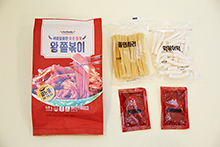
A meal kit provides everything necessary for even beginners to make a meal. From hotteok (sugar-filled griddle cake) and tteokbokki (spicy rice cakes) to naengmyeon (cold buckwheat noodles), there are plenty of Korean food meal kits to try.
Meal kits can be purchased at convenience stores, supermarkets, and department stores. For meal kits found at the refrigerator section, they must be kept cool or refrigerated before and after arriving home. Depending on the kit, cooking appliances such as pot or oven may be required.
Korean Snacks
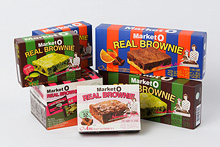
Korea has a wide range of snack items, from sweet snacks perfect as desserts to salty and spicy snacks that stimulate your appetite. Korean snacks are not only tasty but also nicely packaged, making them a very popular souvenir.
Popular snacks and chips are often available in new variations of flavors. Shop for products introduced in Youtube to try snacks in different flavors.
Traditional Korean Snacks
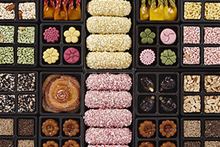
The most representative traditional snacks in Korea are tteok (rice cakes) and hangwa (traditional Korean sweets). Depending on the ingredients and methods, there are over 200 ways to make tteok. Hangwa is made from flour mixed with honey or sugar, which is deep-fried to make snacks such as yugwa (deep-fried sweet rice cake) and yakgwa (traditional honey cookie). They can be eaten as everyday snacks, but are usually served on special occasions such as weddings, birthdays, and Seollal (Korean New Year’s Day) and Chuseok (Korean Thanksgiving Day) holiday.
Hangwa snacks are readily available in a range of prices in department stores and supermarkets. Gift boxes with a variety of hangwa snacks make great souvenirs.
Fruit Vinegar
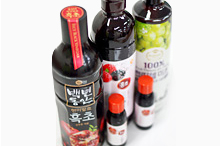
Fruit vinegar is produced by fermented fruits, and has a sweet and sour flavor. It is known for its health benefits, such as improving one's skin tone, and effectiveness in relieving fatigue and constipation. The most common method to consume fruit vinegar is by mixing it with water. A 3:1 ratio of water to fruit vinegar is the general rule of thumb; the ratio can vary depending on personal preference in taste. A variety of fruit vinegar flavors are available such as pomegranate, blueberry, bokbunja (Korean black raspberry) and more. The vinegar can also be used to make fruit soju.
Fruit vinegar can be purchased in varying sizes in bottles of 50mℓ to 500mℓ, 900mℓ and 1.8ℓ. The shelf life is approximately 18 months in average from the date of manufacture. It can be stored at room temperature out of direct sunlight but needs to be refrigerated after opening.
Traditional Korean Alcohol

Much like beer in Germany, wine in France, and vodka in Russia, makgeolli and soju are the representative alcoholic beverages of Korea. Makgeolli is made from fermenting rice or wheat and has a smooth, milky color. It has a low alcohol content of 6-13% with a nutty and sweet flavor. Soju, a distilled alcohol with an alcohol content of about 20%, is popular in part due to its relatively low price. Recently, fruit-flavored soju has been gaining popularity for its sweet taste and less harsh smell.
Makgeolli and soju can be easily purchased in convenience stores, supermarkets and corner stores in even the smallest of towns. The packaging of soju varies from drink boxes to plastic bottles. As alcohol purchases by minors are strictly prohibited in Korea, a form of photo identification with the date of birth is required.
Traditional Korean Tea
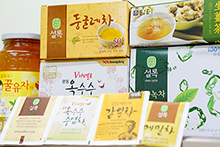
Traditional Korean teas have various flavors and effects. Representative Korean traditional teas include nokcha (green tea), yujacha (citrus tea), maesilcha (green plum tea), mogwacha (Chinese quince tea), omijacha (five-flavor berry tea), and saenggangcha (ginger tea), as well as sikhye (sweet rice drink) and sujeonggwa (cinnamon punch). Nokcha is made from tea leaves that have a bitter and refreshing taste. While green tea is traditionally enjoyed by steeping dried and roasted green tea leaves in hot water; these days green tea is available in powder form as well as in teabags. Yujacha, maesilcha, mogwacha, omijacha, and saenggangcha are made from fruits sliced and preserved in sugar or honey. Sikhye is a sweet drink made with rice that aids with digestion. Sujeonggwa tastes sweet with a kick of spice; it contains ginger and cinnamon boiled in sugar water, which is chilled and served cold.
Traditional teas are available in supermarkets, department stores, and convenience stores. There is a wide variety of green tea products sold in the form of powder, teabags, or whole roasted leaves. Yujacha, mogwacha and saenggangcha are sold in glass jars but also come in the form of powder, packets or tea bags. Sikhye and sujeonggwa are sold in cans or plastic bottles.
This page was last updated on October 12, 2021, and therefore information may differ from what is presented here.
